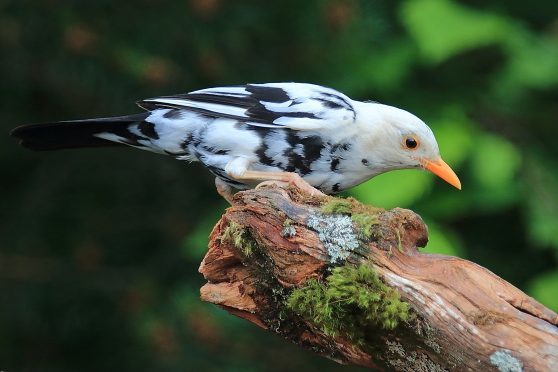They are one of the UK’s most ubiquitous and beloved species of garden guests, coming third in a recent vote to find Britain’s national bird.
But when north-east photographer Peter Lewis heard about an abnormal avian swooping around the trees of a Highland caravan park, he had no idea the mysterious black and white creature with an orange beak would turn out to be a blackbird.
Mr Lewis, from Peterhead, had heard about the unusual animal from local twitchers in Grantown-on-Spey after they spotted it close to the town’s caravan park.
And after laying out some bait to lure the bird out, he snapped these amazing pictures of the creature’s eye-catching black and white plumage on July 7.
White feathers appearing on blackbirds is fairly common, but Mr Lewis said he had never seen one so vibrantly speckled.
The 51-year-old said: “I go up to the Grantown area quite a lot for my wildlife photography, and I had been up this time to try and spot some golden eagles and mountain hares.
“My pal had told me that he had seen a black and white bird with an orange beak around the caravan park, and at first I thought it was a oyster catcher but I was really surprised when I saw it to find that it was a blackbird.
“I coaxed the bird out with some suet and managed to get a good few photographs of it before it flew back into the trees, it was really shy.”
Many birds in the UK occasionally exhibit the white plumage of the blackbird photographed by Mr Lewis because of a condition known as leucism, a biological abnormality which alters pigmentation.
It is distinct from albinism as animals affected retain their naturally dark-coloured eyes, as opposed to the red or pink eyes present in albino creatures.
Leucism is common among most British species, however it is most noticeable in birds of darker plumage such as blackbirds.
Mr Lewis said: “I’ve seen a good few birds, and even some blackbirds with white feathers, but never one this white before, and it made for some beautiful shots.”
